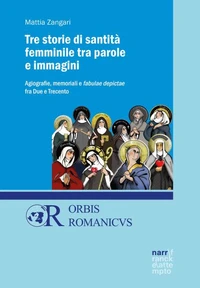Pazze di Lui - Mad for Him: Hagiographic Stereotypes, Mental Disturbances and Anthropological Implications of Female Saintliness in Italy and Abroad from the 13th to the 20th Century
Par :Formats :
Disponible dans votre compte client Decitre ou Furet du Nord dès validation de votre commande. Le format ePub est :
- Compatible avec une lecture sur My Vivlio (smartphone, tablette, ordinateur)
- Compatible avec une lecture sur liseuses Vivlio
- Pour les liseuses autres que Vivlio, vous devez utiliser le logiciel Adobe Digital Edition. Non compatible avec la lecture sur les liseuses Kindle, Remarkable et Sony
 , qui est-ce ?
, qui est-ce ?Notre partenaire de plateforme de lecture numérique où vous retrouverez l'ensemble de vos ebooks gratuitement
Pour en savoir plus sur nos ebooks, consultez notre aide en ligne ici
- Nombre de pages231
- FormatePub
- ISBN978-3-381-11113-8
- EAN9783381111138
- Date de parution17/06/2024
- Protection num.Digital Watermarking
- Taille11 Mo
- Infos supplémentairesepub
- ÉditeurNarr Francke Attempto Verlag
Résumé
The aim of this book is to investigate the delicate relationship between female sanctity and madness, in a time-frame extending from medieval until contemporary times. Constellated by visions, ecstatic raptures, morbid rituals, stigmata and obsessions, the complex phenomenology of female mysticism appears in fact to be articulated and polymorphous, traversed by 'representations' that it seems possible to link to the wide spectrum of mental disorders, as well to the hagiographic stereotypes and anthropological implications.
Male and female scholars from different disciplines (from history to philology, from anthropology to art history, from theology to literary criticism, from psychiatry to psychoanalysis) try to outline a thematic and problematic itinerary, intended to examine, step by step, potential pathological aspects and contexts of reference for the purpose of attempting to reconstruct the complex evolutionary trajectory of female mystical language.
Male and female scholars from different disciplines (from history to philology, from anthropology to art history, from theology to literary criticism, from psychiatry to psychoanalysis) try to outline a thematic and problematic itinerary, intended to examine, step by step, potential pathological aspects and contexts of reference for the purpose of attempting to reconstruct the complex evolutionary trajectory of female mystical language.
The aim of this book is to investigate the delicate relationship between female sanctity and madness, in a time-frame extending from medieval until contemporary times. Constellated by visions, ecstatic raptures, morbid rituals, stigmata and obsessions, the complex phenomenology of female mysticism appears in fact to be articulated and polymorphous, traversed by 'representations' that it seems possible to link to the wide spectrum of mental disorders, as well to the hagiographic stereotypes and anthropological implications.
Male and female scholars from different disciplines (from history to philology, from anthropology to art history, from theology to literary criticism, from psychiatry to psychoanalysis) try to outline a thematic and problematic itinerary, intended to examine, step by step, potential pathological aspects and contexts of reference for the purpose of attempting to reconstruct the complex evolutionary trajectory of female mystical language.
Male and female scholars from different disciplines (from history to philology, from anthropology to art history, from theology to literary criticism, from psychiatry to psychoanalysis) try to outline a thematic and problematic itinerary, intended to examine, step by step, potential pathological aspects and contexts of reference for the purpose of attempting to reconstruct the complex evolutionary trajectory of female mystical language.


